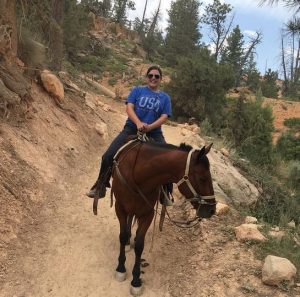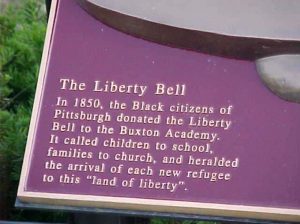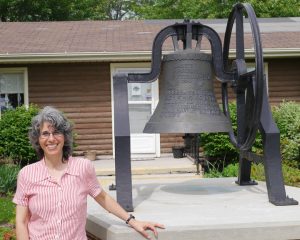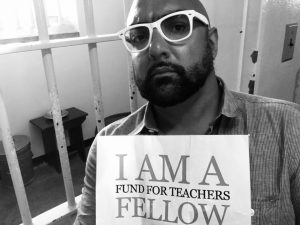Amy McDonald (Shades Valley High School – Birmingham, AL) recently sat beside Max Steinmetz at Temple Emanu-El, signing books and greeting visitors at an event hosted by Birmingham’s Holocaust Education Center. The two are old friends and partners in educating the next generation about the Holocaust, but on this day, they are author and subject of Amy’s new book, Determined to Survive: A Story of Survival and One Teacher’s Passion to Bring That Story to Life.
 Max annually visits with Amy’s AP United States History students to talk about his childhood in Targu Lapus, Romania, and his family’s imprisonment in the Szaszregen Ghetto before being sent to Auschwitz-Birkenau concentration camp/killing center.
Max annually visits with Amy’s AP United States History students to talk about his childhood in Targu Lapus, Romania, and his family’s imprisonment in the Szaszregen Ghetto before being sent to Auschwitz-Birkenau concentration camp/killing center.
Last year, Max and his wife asked Amy to share his story in writing. She was honored and humbled and agreed.
By using her Fund for Teachers grant to witness places she had heard Max reference with students, Amy was able to bring his story and this book project full circle, not just for her students and other students in Alabama and the United States, but also those in Max’s hometown of Targu Lapus. Additionally, she also now:
- Combines the approaches of teaching the historical context of an event while engaging students with the personal stories and experiences of individuals and groups;
- Challenges students with not just the facts and statistics of what happened during the Holocaust, but by tackling the more complex questions of how and why it happened;
- Collaborates with a Romanian high school teacher on ways to connect classrooms and students;
- Combines teaching the history of the Holocaust with the power of one person’s story;
- Provides students with a first-hand account of the background knowledge of a local Holocaust survivor’s life, knowledge that can be transferred in the forms of world geography, cultural studies, world religions and the history of the Holocaust;
- Makes the numbers, statistics and documentary footage of the Holocaust more personal
- Leverages real-world connections, both locally and in Romania, to collaborate on shared projects such as common readings, You Tube videos and interactive presentations; and,
- Confronts students with how genocide, hate and intolerance impacted individuals, families, and communities, lessons that can be applied in today’s climate of terror, intolerance and prejudice.
Below Amy shares more about how her time in Romania impacted her, her teaching and her students:
“It is impossible to write in a few lines how much I was impacted by visiting Munich, Germany, as well as Targu Lapus and other sites in northern Romania. It was an amazing experience and beyond anything I could have ever expected,” said Amy of her fellowship. “While I saw many important sites, the most valuable and touching times were those spent with teachers and students. Their hospitality, warmth and kindness were truly humbling. Their openness to Max’s story was genuine, and their messages, words and gifts back to him were ones of respect and admiration.
There is much work to be done here, and my belief in the value of Holocaust Education was
strengthened even more. This fellowship shaped the experience of my Holocaust Studies class as more than an exchange of information. It allowed me to make the numbers, statistics and documentary footage of the Holocaust more personal. Holocaust education is in a state of transition as survivor witnesses become fewer and fewer. New approaches will be needed to maintain the intimacy of this history that we have been so fortunate to experience. We must prepare ourselves to continue to tell their stories as they have so bravely done in their efforts to ensure that all of those lives lost would not be in vain and that we “Never forget.”
As the plane leaving Romania carried me back home, I had the thought that regarding Max’s story, I had hopefully left no stone unturned. I had now done all I could possibly do. I suddenly realized that I had not. Teachers are never finished. I am only just beginning.”
Read more about Max and Amy’s research on his remarkable life at http://bit.ly/FFTSurvivor.
 Deborah Howard and Judith Fitzgerald (Naubuc Elementary – Glastonbury, CT) spent a week this summer at the
Deborah Howard and Judith Fitzgerald (Naubuc Elementary – Glastonbury, CT) spent a week this summer at the  For 18 days and culminating in
For 18 days and culminating in  “My students might not ever see a geyser or ride a mule into a rocky canyon, but they will know someone who has,” said Cassie. “Often, as educators, we teach our students information straight from a resource book or textbook teacher edition. Now, my teaching of the Southwest and West region of the United States will be more than rote facts and small snapshots. My trip will fuel their desire to set out and experience our national parks for themselves one day.”
“My students might not ever see a geyser or ride a mule into a rocky canyon, but they will know someone who has,” said Cassie. “Often, as educators, we teach our students information straight from a resource book or textbook teacher edition. Now, my teaching of the Southwest and West region of the United States will be more than rote facts and small snapshots. My trip will fuel their desire to set out and experience our national parks for themselves one day.” “My fellowship underscored the importance of integrating history, particularly the history of African Americans before the Civil War, into my language arts curriculum,” said Melissa. “I experienced first-hand the power of individual stories, of people’s personal experiences, and the ways they help make history come alive.”
“My fellowship underscored the importance of integrating history, particularly the history of African Americans before the Civil War, into my language arts curriculum,” said Melissa. “I experienced first-hand the power of individual stories, of people’s personal experiences, and the ways they help make history come alive.” Another local she talked with during her travels encouraged a visit to Buxton in Ontario, a community founded in 1849 for Blacks who were fleeing slavery in the US. The
Another local she talked with during her travels encouraged a visit to Buxton in Ontario, a community founded in 1849 for Blacks who were fleeing slavery in the US. The  Paul Curtis books,
Paul Curtis books, 





 Although the impact of our fellowship in the classroom and community is just beginning, it mirrors this year’s school theme, “From Small Beginnings Come Great Things at USE,” inspired by our fellowship and new school-wide garden. T-shirts bearing the slogan were made for all the staff and sold to students and families by the PTA. With information acquired through our meeting with the town council of Capannori during our fellowship, we are expanding our school-wide recycling program, as well as the program that donates unopened milk and food items to non-profit organizations. We are also implementing a school composting program, run by our student council, to facilitate student awareness of how prior waste becomes nutrient rich soil.
Although the impact of our fellowship in the classroom and community is just beginning, it mirrors this year’s school theme, “From Small Beginnings Come Great Things at USE,” inspired by our fellowship and new school-wide garden. T-shirts bearing the slogan were made for all the staff and sold to students and families by the PTA. With information acquired through our meeting with the town council of Capannori during our fellowship, we are expanding our school-wide recycling program, as well as the program that donates unopened milk and food items to non-profit organizations. We are also implementing a school composting program, run by our student council, to facilitate student awareness of how prior waste becomes nutrient rich soil.






